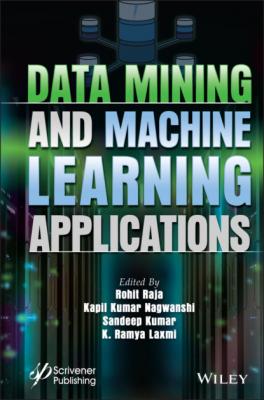Data Mining and Machine Learning Applications. Группа авторов
Чтение книги онлайн.
Читать онлайн книгу Data Mining and Machine Learning Applications - Группа авторов страница 15
 show the complete workflow for selecting a Workspace path, and if you want to change the way, you can change it by clicking on the “Browse.” Finally, Figure 1.16 gives you the home screen for mining purpose.
show the complete workflow for selecting a Workspace path, and if you want to change the way, you can change it by clicking on the “Browse.” Finally, Figure 1.16 gives you the home screen for mining purpose.
Figure 1.9 Selecting directory as a workspace.
Figure 1.10 Starting KNIME.
Figure 1.11 Completing setup wizard.
Figure 1.12 Installing Workspace in KNIME.
Figure 1.13 Installing KNIME (2).
Figure 1.14 Specifying memory for KNIME.
Figure 1.15 Finalizing the installation of KNIME.
Figure 1.16 Initial screen of KNIME.
1.7.3 Rapid Miner
One can visit https://rapidminer.com/products/studio/ for further instructions to download this tool. Its main features are as follows speedy creation of predictive models; Rich set of libraries to build the model like Bayesian modeling, Regression, Clustering, Neural networks, Decision trees. A rapid miner comes with templates, which are provided for guidance. One can use any data source like MS-excel, Access, CSV, NoSQL, MongoDB, Microsoft SQL Server, MySQL, Cassandra, PDF, HTML, XML. Rapid Miner Supports ETL (extract–transform–load), multiple file types, and Data exploration using exact statistical analysis. The Code control & management module is responsible for Background process execution, Automatic optimization, Scripting, Macros, Logging, Process control, and Process-based reporting. One can obtain good visualization using Scatter, scatter matrices, Line, Bubble, Parallel, Deviation, Box, 3-D, Density, Histograms, Area, Bar charts, stacked bars, Pie charts, Survey plots, Self-organizing maps, Andrews curves, Quartile, Surface/contour plots, time series plots, Pareto/lift chart. And finally, One can validate the designed model before deployment through Split validation, Bootstrapping, Batch cross-validation, Wrapper cross-validation, Lift chart, and Confusion matrix [24].
References
1. Silberschatz, A., Korth, H.F., Sudarshan, S., Database system concepts, Mcgraw-hill, New York, 1997.
2. Fayyad, U., Piatetsky-Shapiro, G., Smyth, P., From data mining to knowledge discovery in databases. AI Mag., 17, 3, 37–37, 1996.
3. Tan, P.-N., Steinbach, M., Kumar, V., Introduction to data mining, Pearson Education India, New Delhi, 2016.
4. Sumathi, S. and Sivanandam, S.N., Introduction to data mining and its applications, vol. 29, Springer, Berlin Heidelberg, 2006.
5. Mehrotra, S., Rastogi, R., Korth, H.F., Silberschatz, A., A transaction model for multidatabase systems, in: ICDCS, pp. 56–63. Mining, What Is Data. “Data mining: Concepts and techniques, vol. 10, pp. 559–569, Morgan Kaufmann, 2006.
6. Pyo, S., Uysal, M., Chang, H., Knowledge discovery in the database for tourist destinations. J. Travel Res., California, USA, 40, 4, 374–384, 2002.
7. Gehrke, J., Ginsparg, P., Kleinberg, J., Overview of the 2003 KDD Cup. ACM Sigkdd Explor. Newsl., 5, 2, 149–151, 2003.
8. Shafique, U. and Qaiser, H., A comparative study of data mining process models (KDD, CRISP-DM, and SEMMA). Int. J. Innov. Sci. Res., 12, 1, 217–222, 2014.
9. Mennis, J. and Peuquet, D.J., The role of knowledge representation in geographic knowledge discovery: A case study. Trans. GIS, 7, 3, 371–391, 2003.
10. Mahmood, M.R., Patra, R.K., Raja, R., Sinha, G.R., A Novel Approach for Weather prediction using forecasting analysis and Data Mining Techniques, in: 7th International Conference on Innovations in Computer Science and Engineering on 27–28 July 2018, 2018.
11. Han, J., Kamber, M., Pei, J., Data mining concepts and techniques, third edition, The Morgan Kaufmann Series in Data Management Systems, vol. 5(4), pp. 83–124, Elsevier, Massachusetts, USA, 2011.
12. Zhang, S., Zhang, C., Yang, Q., Data preparation for data mining. Appl. Artif. Intell., 17, 5–6, 375–381, 2003.
13. Agarwal, S., Data mining: Data mining concepts and techniques. 2013 International Conference on Machine Intelligence and Research Advancement, IEEE, 2013.
14. Pathak, S., Raja, R., Sharma, V., Ramya Laxmi, K., A Framework Of ICT Implementation On Higher Educational Institution With Data Mining Approach. Eur. J. Eng. Res. Sci., 4, 5, 2019.
15. Barbará, D. and Jajodia, S. (Eds.), Applications of Data Mining in Computer Security, vol. 6, Springer Science & Business Media, Berlin Heidelberg, 2002.
16. Chen, M.-S., Han, J., Yu, P.S., Data mining: An overview from a database perspective. IEEE Trans. Knowl. Data Eng., 8, 6, 866–883, 1996.
17. Tanveer, S.K., Mining regular patterns in transactional databases. IEICE Trans. Inf. Syst., 91, 11, 2568–2577, 2008.
18. Pathak, S., Bhatt, P., Raja, R., Sharma, V., Weka vs Rapid Miner: Models Comparison in Higher Education with these Two Tools of Data. SAMRIDDHI: A J. Phys. Sciences, Engineering, Technol., 12, Special Issue (3), 183–188, 2019.
19. Gabriel, R., Gluchowski, P., Pasta, A., Data warehouse & data mining, W3l GmbH, Münster, Germany, 2009.
20. Bowles, M., Machine learning in Python: Essential techniques for predictive analysis, John Wiley & Sons, New York, USA, 2015.
21. Nagwanshi, K.K., Atulkar, M., Durugkar, S., Learn Python by Experiments, Educreation Publishing, New Delhi, 2021.
22. Raj, A.P.,